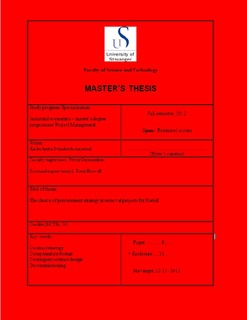| dc.contributor.author | Aaserud Svindseth, Karin Anita | |
| dc.date.accessioned | 2014-02-06T08:53:57Z | |
| dc.date.issued | 2012-12 | |
| dc.identifier.uri | http://hdl.handle.net/11250/182304 | |
| dc.description | Master's thesis in Industrial economics | no_NO |
| dc.description.abstract | 56 years have gone since the first well was drilled at the Norwegian continental shelf (1). Today, many of the installations are old and no longer in use, and according to the OSPAR Convention 98/3 (2) they shall be removed. Based on this, the Cessation Projects portfolio in Statoil was established late 2009/start 2010. The portfolio consists of 10 very different (both in size and complexity) removal projects, none of which per today are finished. Statoil has no significant previous experience with removal projects prior to the establishment of the Cessation portfolio, so this is a new area to Statoil.
Very few of these projects have been executed in the industry as a whole, and factors such as high oil price, new technology and maintenance cost extends the field lifetimes, resulting in removal projects being postponed, giving them a very volatile character. These projects also differ from development and modification projects, as there are no “first oil” calculations or lost money due to production stop. The current high investment level on the Norwegian continental shelf also represents a challenge for these projects, as they often compete over the same resources as in the supplier industry. In addition, the small amount of experience with removal projects among both suppliers and operators make these projects challenging.
The purpose of this thesis is to look into the choice of procurement strategy for removal projects in Statoil. 6 contracts for 3 different projects have been awarded in the Cessation project portfolio per today (11/2012). The total contract value for these 6 contracts is 1.253 billion NOK. And the total contracted value will only increase with the progress in the portfolio. As Statoil`s current execution strategy for these projects is to award a EPR (D) -contract (Engineering, Preparation, Removal and Disposal) to one supplier, the procurement strategy and well designed contracts becomes crucial to cost efficient spending and effective project execution. The challenges represented in the section above and the little experience in the industry with removal projects makes the establishment of a procurement strategy complex. But, the task is no less important as the allocation of risk and design of incentive mechanisms is an important tool for Statoil to be able to reach its goal of “safe and cost efficient (3)” execution of these projects. | no_NO |
| dc.description.sponsorship | Statoil | no_NO |
| dc.publisher | University of Stavanger, Norway | no_NO |
| dc.relation.ispartofseries | Masteroppgave/UIS-TN-IØRP/2012; | |
| dc.subject | procurement | no_NO |
| dc.subject | contract strategy | no_NO |
| dc.subject | decommissioning | no_NO |
| dc.subject | industriell økonomi | no_NO |
| dc.title | The choice of procurment strategy in removal projects for Statoil | no_NO |
| dc.type | Master thesis | no_NO |
| dc.subject.nsi | VDP::Social science: 200::Economics: 210::Economics: 212 | no_NO |
| dc.description.embargo | 2018-01-01 | |
